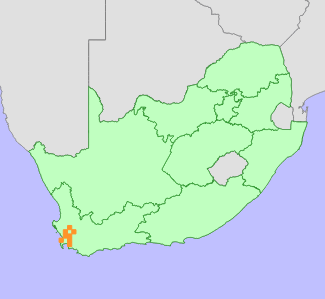|
Scientific Name | Disa tenella (L.f.) Sw. subsp. tenella |
Higher Classification | Monocotyledons |
Family | ORCHIDACEAE |
Synonyms | Orchis tenella L.f., Orchis tenuifolia Burm.f., Satyrium tenellum (L.f.) Thunb. |
National Status |
Status and Criteria | Endangered B1ab(i,ii,iii,iv,v)+2ab(i,ii,iii,iv,v) |
Assessment Date | 2012/08/31 |
Assessor(s) | L. von Staden, I. Ebrahim, C. von Witt, B. Bytebier & W.R. Liltved |
Justification | EOO 2105 km², three to four locations remain. More than 50% of historic records (1950s and earlier) are from locations that have been lost to urban development. This species continues to decline due to expanding agriculture and alien plant invasion. |
Distribution |
Endemism | South African endemic |
Provincial distribution | Western Cape |
Range | Porterville to Malmesbury and Gordon's Bay. Extinct on the Cape Flats. |
Habitat and Ecology |
Major system | Terrestrial |
Major habitats | Swartland Granite Renosterveld, Boland Granite Fynbos, Cape Flats Sand Fynbos, Atlantis Sand Fynbos, Lourensford Alluvium Fynbos, Swartland Alluvium Fynbos, Breede Alluvium Fynbos |
Description | Damp, seasonally wet depressions in sand or clay, 0-200 m. |
Threats |
| Due to severe transformation of lowland ecosystems through urban development, agriculture and proliferation of introduced invasive alien species, once common geophytes such as D. tenella subsp. tenella are increasingly threatened or face extinction. (Liltved and Johnson, unpubl.) Over 65% of this species' lowland habitat has already been transformed, and remaining subpopulations are confined to small fragments within urban and agricultural landscapes. Urban development in the Strand area has led to recent loss of a subpopulation on Disa road near Harmony Flats (Raimondo pers. obs. 2005). Three remaining subpopulations are threatened by spreading alien invasive plants, while two are threatened by ongoing agricultural expansion. |
Population |
The distribution range of this formerly widespread taxon has been much reduced by extensive habitat loss, and it is now extinct on the Cape Flats. Currently three remaining subpopulations are known, all occurring on small fragments. The largest subpopulation of over 1000 plants occur within a small provincial nature reserve (1000 ha), and is dependent on ongoing management and clearing of alien invasive plants for its survival. A second subpopulation of about 100 mature individuals occur in a small urban minicipal reserve (9 ha), but is threatened by ongoing degradation of its habitat. A third subpopulation of about 200 mature individuals was recently discovered on another small fragment (24 ha) on privately owned land surrounded by crop fields. At a fourth site, another small fragment (80 ha) that is threatened by ongoing agricultural expansion, a single plant was found in 2002. The identity of this specimen however could not be determined with certainty.
|
Population trend | Decreasing |
Notes |
| Flowers annually, effect of fires on flowering are not understood (Liltved and Johnson, unpubl.). |
Assessment History |
Taxon assessed |
Status and Criteria |
Citation/Red List version | | Disa tenella (L.f.) Sw. subsp. tenella | EN B1ab(iii,iv,v)+2ab(iii,iv,v) | Raimondo et al. (2009) | | Disa tenella (L.f.) Sw. subsp. tenella | VU A1c | Victor (2002) | | Disa tenella (L.f.) Sw. subsp. tenella | Vulnerable | Hilton-Taylor (1996) | |
Bibliography |
Hilton-Taylor, C. 1996. Red data list of southern African plants. Strelitzia 4. South African National Botanical Institute, Pretoria.
Liltved, W.R. and Johnson, S.D. Unpublished. The Cape Orchids - Wild orchids of the Cape Floral Kingdom.
Linder, H.P. 1981. Taxonomic studies in the Disinae. III. A revision of Disa Berg. excluding sect. Micranthae Lindl. Contributions from the Bolus Herbarium 9:1-370.
Linder, H.P. and Kurzweil, H. 1999. Orchids of southern Africa. A.A. Balkema, Rotterdam.
Raimondo, D., von Staden, L., Foden, W., Victor, J.E., Helme, N.A., Turner, R.C., Kamundi, D.A. and Manyama, P.A. 2009. Red List of South African Plants. Strelitzia 25. South African National Biodiversity Institute, Pretoria.
Victor, J.E. 2002. South Africa. In: J.S. Golding (ed), Southern African plant Red Data Lists. Southern African Botanical Diversity Network Report 14 (pp. 93-120), SABONET, Pretoria.
|
Citation |
| von Staden, L., Ebrahim, I., von Witt, C., Bytebier, B. & Liltved, W.R. 2012. Disa tenella (L.f.) Sw. subsp. tenella. National Assessment: Red List of South African Plants version 2024.1. Accessed on 2025/12/13 |
 Comment on this assessment
Comment on this assessment


